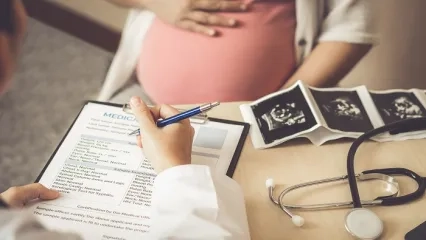Alo Yeditepe
Alo Yeditepe
Fetal Anomalies in Consanguineous Marriages Can Be Diagnosed in the Womb
Consanguineous marriage occurs at a rate of 12–13% globally on average, but it doubles in Turkey. Stating that this issue is of particular importance in terms of birth defects and for this reason, people who are known to be related should receive genetic counseling before conception, Gynecology, Obstetrics, and Perinatology specialist Prof. Dr. Mustafa Başbuğ said that today it is possible to diagnose some fetal anomalies that may occur as a result of consanguineous marriages in the womb.
Prof. Dr. Mustafa Basbug, an obstetrics and perinatology specialist at Yeditepe University Kozyatagi Hospital, emphasized that fetal anomalies caused by consanguineous marriages are significantly more common than those caused by unrelated marriages. He added that this issue has become much more important when taking into account the prevalence of consanguineous marriages in our nation. Prof. Dr. Mustafa Basbug made significant claims about the embryonic abnormalities brought on by consanguineous marriages.
Stating that the diseases in these marriages are transmitted to the fetus by recessive genes, Yeditepe University Kozyatagi Hospital Obstetrics and Gynecology and Perinatology Specialist Prof. Dr. Basbug said ''Although the mother and father are healthy, if both the mother and father have recessive genes, the rate of encountering fetal disabilities at birth is 25%.''
The Closer the Kinship Level, the Higher the Risk of Fetal Injury
Reminding that a quarter of marriages in our country consist of different levels of kinship, Prof. Dr. Mustafa Basbug continued as follows: ''We acknowledge consanguineous marriages because of the possibility of prenatal problems. There are 3% of what we refer to as significant anomalies around the globe, including spinal openings, brain damage, and cardiac severe anomalies. With minor fetal anomalies, this rate can be as high as 10 to 13%. This rate roughly doubles in consanguineous unions, and the closer the consanguinity, the greater the rate.''
In the Womb, Up To 85% Of Diagnoses Can Be Confirmed!
According to Prof. Dr. Mustafa Basbug, depending on whether the relevant conditions are met, a diagnosis of handicapped newborns in the womb in consanguineous marriages can be made up to 85% of the time:
''The crucial aspect of consanguineous unions is that the sickness is transmitted to the child who carries the recessive gene. Even if both parents are healthy, there is a 25% chance of a child being born disabled if both parents carry certain genes. If there are ultrasound results, tests are conducted to see if a chromosomal or non-chromosomal syndrome is present. Up to 80%–85% of diagnoses can be made if the ultrasound data are carefully analyzed and genetic analyses are employed. It should be highlighted, nevertheless, that genetic testing is crucial at this time. Sadly, it is not possible to diagnose several metabolic illnesses and muscle diseases intrauterinally. There is no ultrasound discovery if neither the mother nor the father previously had this condition or if the genes are unknown.''
What Method Should Families Follow?
The following information was provided by Prof. Dr. Mustafa Basbug regarding the procedures to be followed for the diagnosis of fetal abnormalities resulting from consanguineous marriages:
''Prior to becoming pregnant, those who are known to be related should have genetic counseling. Following conception, the required fetal examinations should be conducted every day. Neck thickness, a thorough first-trimester ultrasonography examination at 11–14 weeks, a thorough second-trimester echocardiography examination at 18–23 weeks, a thorough examination for brain system and extremity anomalies—all fetal organs should be thoroughly inspected. Because some discoveries allow us to directly diagnose specific conditions. Chromosomes are normal, but all tests for single gene illnesses must be performed, especially if consanguineous marriages and fetal malformations are present.''
“Diagnosis of SMA Muscle Disease Cannot Be Directly Diagnosed with Ultrasound”
Underlining that the inability to diagnose fetal anomaly in the womb can cause significant losses in terms of both family psychology and the country's economy, Prof. Dr. Mustafa Basbug stated that ultrasound could not be used to directly diagnose the SMA muscle disorder, which has been discussed frequently lately.
Underlining that muscle diseases progress with muscle weakness and emerge later after birth, that is, as the baby grows, Prof. Dr. Basbug continued as follows: “However, by removing a piece from the child's spouse (placenta) as early as 11 to 14 weeks and sending it to genetics, we can identify these genes if it is known that a family has a history of muscle illness and the spouses are carriers.”
It Can Also Be Diagnosed in Non-Relative Couples
In addition, Prof. Dr. Basbug of Yeditepe University Kozyatagi Hospital Obstetrics and Gynecology and Perinatology said that fetal anomalies can be understood with ultrasound and some examinations, whether there is kinship or not in some diseases, and that some diseases can be detected with ultrasound. "For instance, between the 11th and 14th weeks, we do the transparency test, which we refer to as the nape thickness test. The frequency of chromosomal abnormalities and other damage increases with increasing thickness in this area. We state that genetic testing for chromosomal defects should be done if the nape thickness test is high and the conditions, we determined are present. Further testing is extremely necessary even if there is no chromosomal issue, particularly if there is kinship and a thick neck."
Press Coverage: cnnturk | medyatava | oncevatan | yenicaggazetesi | sondakika | beyazhaberajansi | cumhuriyet
About
Faculty and Year of Graduation:
Ankara University Medical Faculty, 1988
Alo Yeditepe





